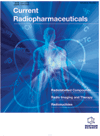- Home
- A-Z Publications
- Current Radiopharmaceuticals
- Previous Issues
- Volume 8, Issue 2, 2015
Current Radiopharmaceuticals - Volume 8, Issue 2, 2015
Volume 8, Issue 2, 2015
-
-
Evolving Important Role of Lutetium-177 for Therapeutic Nuclear Medicine
More LessAuthors: Ambikalmajan M.R. Pillai and Furn F. (Russ) KnappLutetium-177 (177Lu) is a late entrant into the nuclear medicine therapy arena but is expected to become one of the most widely used therapeutic radionuclides. This paper analyses the reason for the increasing preference of 177Lu as a therapeutic radionuclide. While the radionuclidic properties favor its use for several therapeutic applications, the potential for large scale production of 177Lu is also an important aspect Read More
-
-
-
Chemistry and bifunctional chelating agents for binding 177Lu
More LessAuthors: Jozef L. Parus, Dariusz Pawlak, Renata Mikolajczak and Adriano DuattiA short overview of fundamental chemistry of lutetium and of structural characteristics of lutetium coordination complexes, as relevant for understanding the properties of lutetium-177 radiopharmaceuticals, is presented. This includes basic concepts on lutetium electronic structure, lanthanide contraction, coordination geometries, behavior in aqueous solution and thermodynamic stability. An illustration of the structu Read More
-
-
-
Production of No-Carrier Added Lutetium-177 by Irradiation of Enriched Ytterbium-176
More LessTwo methods of Lu-177 production are reviewed: irradiation of isotopically enriched Lu- 176 (direct way) and irradiation of ytterbium enriched with Yb-176 (indirect way). Based on neutronphysical calculations Lu-177 yield and specific activity were estimated for both methods. Lu-177 specific activity strongly depends on neutron flux density in the direct way, that is 75,000 Ci/g for 10- days irradiation in a neutron flux of 2.1015 Read More
-
-
-
Indirect Production of No Carrier Added (NCA) 177Lu from Irradiation of Enriched 176Yb: Options for Ytterbium/Lutetium Separation
More LessThis article presents a concise review of the production of no-carrier-added (NCA) 177Lu by the ‘indirect’ route by irradiating ytterbium-176 (176Yb)-enriched targets. The success of this production method depends on the ability to separate the microscopic amounts of NCA 177Lu from bulk irradiated ytterbium targets. The presence of Yb+3 from the target in the final processed 177Lu will adversely affect the quality of Read More
-
-
-
Alternative method to determine Specific Activity of 177Lu by HPLC
More LessAuthors: Wouter A. P. Breeman, Rory M. S. de Zanger, Ho Sze Chan and Erik de BloisPeptide Receptor Radionuclide Therapy (PRRT) with 177Lu-DOTA-peptides requires 177Lu with high specific activity (SA) and values >740 GBq 177Lu per mg Lu to maximise the atom% of 177Lu over total Lu. Vendors provide SA values which are based on activity and mass of the target, whereas due to "burn-up" of target, these SA values are not accurate. For a radiochemist the SA of 177Lu is of interest prior to radiolab Read More
-
-
-
Estimation of specific activity of 177Lu by ‘saturation assay’ principle using DOTA as ligand
More LessAuthors: Ambikalmajan M.R. Pillai, Sudipta Chakraborty and Tapas DasLutetium-177 is a widely used therapeutic radionuclide in targeted therapy and it is important to know its specific activity at the time of radiopharmaceutical preparation, especially for radiolabeling peptides. However, there are no direct methods for the experimental determination of the specific activity which can be readily applied in a hospital radiopharmacy. A new technique based on the ‘saturation assay’ principl Read More
-
-
-
Accurate assessment of whole-body retention for PRRT with 177Lu using paired measurements with external detectors
More LessThe aim of this study was to assess the accuracy of the results of whole-body measurements by comparison with the urine collection method in the PRRT with 177Lu and furthermore to develop a more accurate method of paired measurements. Excreted samples were collected at given intervals and activities were measured by a dose calibrator. Traditionally, whole-body activities during subsequent measurements are no Read More
-
-
-
Radiation Dosimetry Aspects of 177Lu
More LessAuthors: Michael Lassmann and Uta EberleinThis review mainly focuses on the dosimetry methodology which includes consideration of the number and time points of scans, imaging methodology, methods for integrating time-activity curves and calculating absorbed doses. 177Lu-labelled compounds show many advantages for dosimetry assessments due to attractive physical properties which comprise low abundance of photons for sufficient post-therapy imagi Read More
-
-
-
Consequences of meta-stable 177mLu admixture in 177Lu for patient dosimetry
More LessLutetium-177 (177Lu) is a rare earth metal in the lanthanides series which decays by beta emission with a half life of 6.647 days to three excited states and the ground state of 177Hf. When 177Lu is produced by neutron capture in 176Lu, inevitably an admixture is formed of the long-lived isomer 177mLu. As its half-life of 160.4 days is so much longer than that of 177Lu, concerns are raised on its possible enhancement in r Read More
-
-
-
Theranostic Radiopharmaceuticals Based on Gold Nanoparticles Labeled with 177Lu and Conjugated to Peptides
More LessGold nanoparticles (AuNPs) have been proposed for a variety of medical applications such as localized heat sources for cancer treatment and drug delivery systems. The conjugation of peptides to AuNPs produces stable multimeric systems with target-specific molecular recognition. Lutetium- 177 (177Lu) has been successfully used in peptide radionuclide therapy. Recently, 177Lu-AuNPs conjugated to different peptides have be Read More
-
Volumes & issues
Most Read This Month
Article
content/journals/crp
Journal
10
5
false
en


